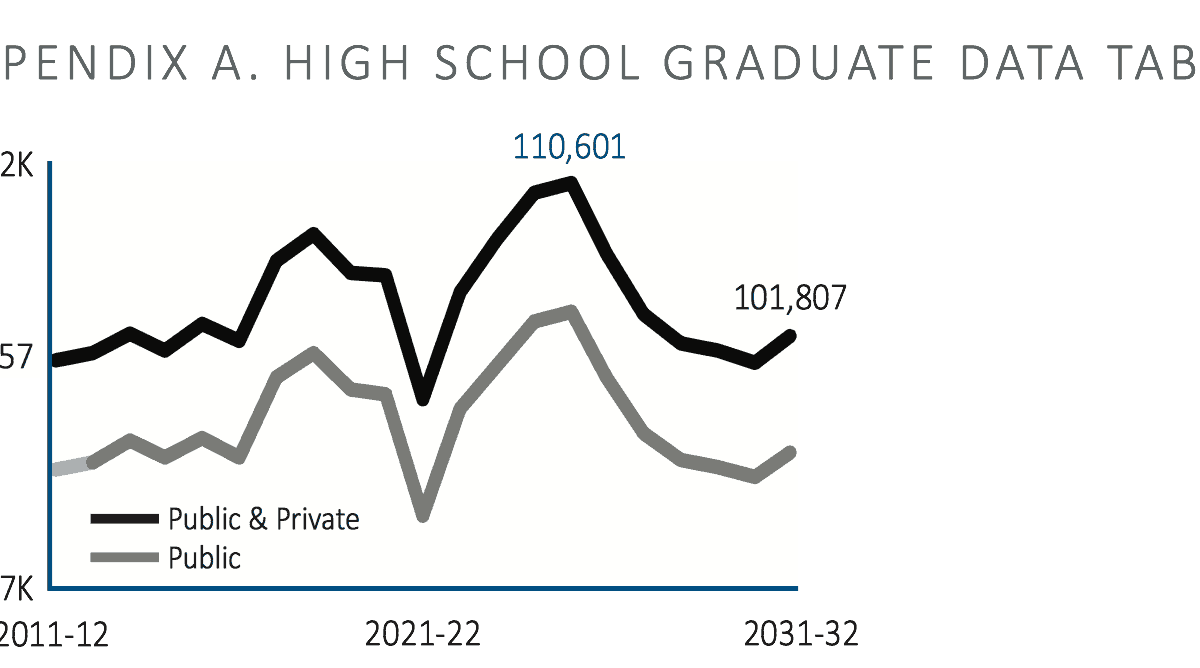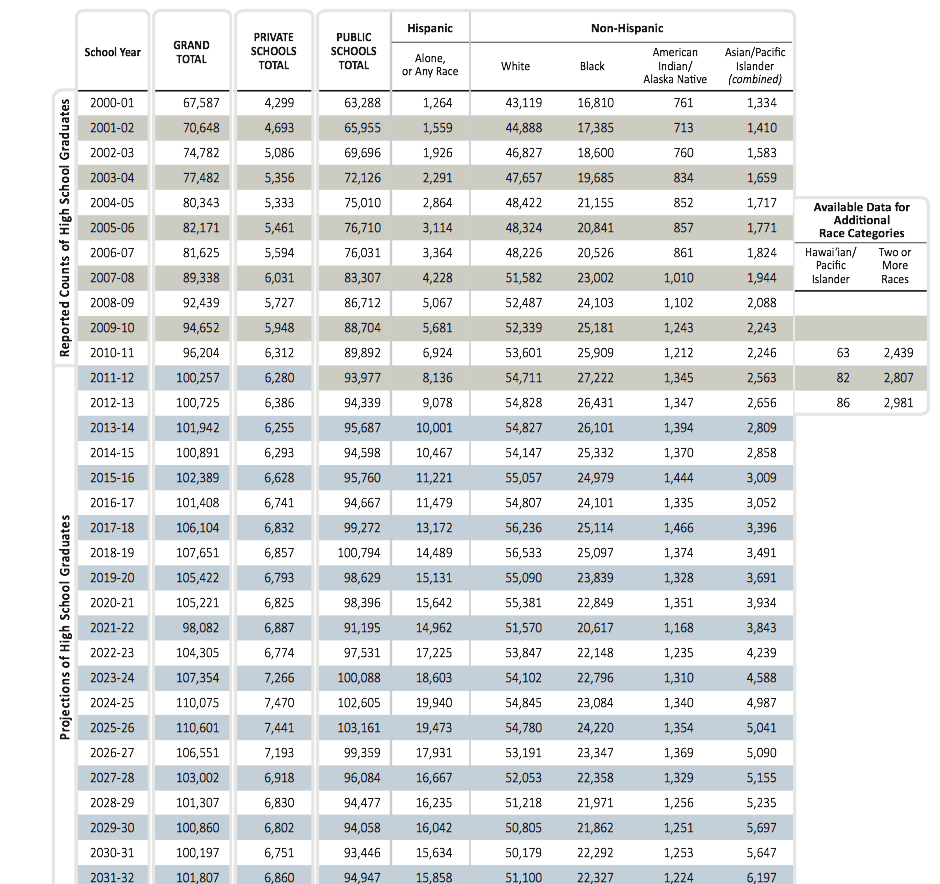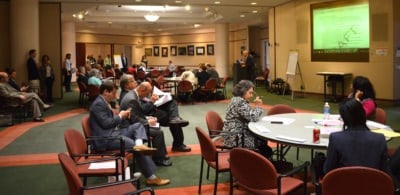

Results from three different organizations came in last week that included data on education in North Carolina.
WICHE
WICHE posted its report on the trends in high school graduation rates in the United States and beyond last week.
In the ninth edition of “Knocking at the College Door: Projections of High School Graduates,” North Carolina got good marks.
According to its website, this report “examines data on public and private schools and projects the number of high school graduates for the nation, four geographic regions, the 50 states, and the District of Columbia. And, for the first time, WICHE also includes projections for Guam and Puerto Rico.”
According to the report, North Carolina is “the 10th highest producer of high school graduates with 103,600 high school graduates, on average, projected per year between school years 2011-12 and 2031-32.”
Further, the report said, “The total number of graduates is projected to increase by 10.3 percent between 2011-12 and 2025-26, the next highest year for North Carolina.”


NCTQ
The National Council on Teacher Quality released data last week on 875 undergraduate elementary teacher preparation programs in the United States. The report evaluates programs, rating the top ones as “those that graduate teachers well versed in both evidence-based content and methods of teaching,” a press release stated.
Three of North Carolina’s undergraduate elementary teacher prep programs received high marks, making it to the 90th percentile overall nationwide or higher: Elon University, High Point University, and Meredith College.
The evaluation used for these undergraduate programs looked at a variety of factors, including how selective the schools are in who they let into the programs, student teaching, reading instruction, math instruction, and coverage of other elementary content. Twenty six NC programs were evaluated in total.
The top three programs from NC listed above all did well in selectivity and two got A’s for student teaching. According to the press release, seven (27 percent) of the state programs evaluated by NCTQ got A’s for their selection criteria of applicants, but 11, (42 percent) got F’s.
The state institutions reviewed did the poorest in elementary math, with 14 (54 percent) of the programs getting an F, while only one received an A.
Of all the state programs reviewed, 17 (63 percent) are below the 50th percentile nationwide, according to the release. Two are unranked.
Some of the programs that ranked below the 50th percentile include North Carolina State University at the 43 percentile, Winston-Salem State University at the 13 percentile, and North Carolina Central University at the 3rd percentile.
For more info on NCTQ, go here. Go here for the rankings of the state’s programs.
In a conference call last week, NCTQ President, Kate Walsh, said that undergraduate elementary teacher prep programs are showing growth. NCTQ has been writing about teacher prep programs since 2006. However, she also said that many teacher prep programs aren’t where they should be.
She said that research indicate that teachers going through a teacher prep program are often no more effective coming into the classroom than teachers who enter schools after only a short period of training.
“There is no data point out there that shows teacher prep functioning as well as it should be,” she said.
Alisa Chapman, Vice President for Academic and University Programs at the University of North Carolina System, said NCTQ is a work in progress that hasn’t necessarily been able to compile data accurately enough to make a solid representation of teacher prep programs around the country.
“I don’t know that they’re entirely there,” she said. “At least, in the teacher prep community, they face a lot of criticism.”
Chapman said that a few years back, the UNC System partnered with NCTQ to try to assess its methodologies and find ways to improve the process.
“We found mixed results in what they’re doing,” she said. “There are some great areas of strength in their methodology, and there were a couple of areas that they measure that didn’t align with the validity of what they were looking at.”
NCTQ was responsive to the criticisms and did try to adjust its methods as a result, but Chapman said there is still more work to do.
“I don’t know that they’ve perfected all of that,” she said.
She also pointed out that in North Carolina, the state has multiple measures to track the success of its teacher prep programs — far more than other states — and more data to work with than NCTQ.
Having said all that, she said holding teacher prep programs accountable is a good thing and that she thinks NCTQ means well.
“I think that the organization is well intentioned to put pressure on teacher preparation to ensure that we prepare educators in quality programs that produce positive outcomes for improving student achievement in public schools,” she said.
PISA
Finally, the Program for International Student Assessment (PISA) dropped last week, showing results for North Carolina schools that the state’s Department of Public Instruction said were promising.
“North Carolina’s participation in PISA provides us with an external measure of our standards and also of our students’ readiness for career and college,” said State Superintendent June Atkinson in a press release. “We are heartened that our state’s performance is in line with the nation’s and that we are competitive against other global education systems. This information will help us as we review content standards and set expectations for the future.”
To give some context, using international assessments, PISA looks at science, reading and math literacy for 15-year-olds in 73 education systems around the world. It happens every three years and has been around since 2000.
North Carolina is one of only two states in the United States that actively participated this go-round — Massachusetts being the other. Puerto Rico also took part. But PISA does also evaluate the US as a whole.
Out of the 73 education systems that participated, North Carolina’s science literacy was better than 41 of them and no different than 18 others, including the US.
Some of the 14 participants that performed better than NC in science are countries like Singapore and Japan, while NC held even with places like the United Kingdom, Australia and France.
In reading literacy, North Carolina did better than 43 of the other participants, and was no different than 20 others, including the US.
And in reading, again Singapore and Japan are two of the 10 that did better than North Carolina, along with Ireland, Finland and Canada, while the state held even with the UK, Spain, France and others.
In math literacy, North Carolina did better than 29 participants, and was no different than eight others, including the US. Of the three subjects examined, this was the one North Carolina did the worst on, being bested by 36 of the other participants.
Singapore and Japan, again, are two of the 36 countries that outperformed NC in the subject area, along with Spain, France, and the Russian Federation. The state held even with countries like Israel, Malta and Lithuania.
The countries listed are just a few examples of the many that participated. To see the complete data, go here.
BEST NC put out a press release targeting North Carolina’s PISA math scores for particular criticism.
“North Carolina’s math scores are troubling, particularly in our knowledge-based, global economy. Our students must be competitive with their peers in other countries,” said BEST NC Board Chairman, Walter McDowell. “The good news is that North Carolina recently implemented new math standards that closely align with Singapore’s, where students have the highest math scores in the world. It will take time to see results on these international exams, but we are setting the right direction with high standards for North Carolina students.”
BEST NC did point out one bright spot in the data. The increasing education equity in North Carolina and the nation.
“A bright light for the U.S., and North Carolina in particular, is the increasing educational equity between more affluent students and those that are economically challenged. Historically, poverty has been a strong predictor of academic outcomes. However, from 2006 to 2015, disadvantaged U.S. students performed above expectations compared to other OECD countries. Excitingly, North Carolina has achieved an even better result. A student’s level of poverty was a 13% predictor of student performance across OECD countries. But in North Carolina, a student’s level of poverty only had a 9% influence. This is good news for North Carolina, as it suggests that, on average, we do a better job of providing equitable educational opportunities than other OECD countries,” the press release stated.
OECD stands for Organization for Economic Cooperation and Development, the organization which coordinates PISA. Thirty five OECD countries were included in the report. OECD includes countries like Finland, Spain, the US, Japan, Israel, France and others.
BEST NC describes itself as “a non-profit, non-partisan coalition of business leaders committed to improving North Carolina’s education system through policy and advocacy.”


